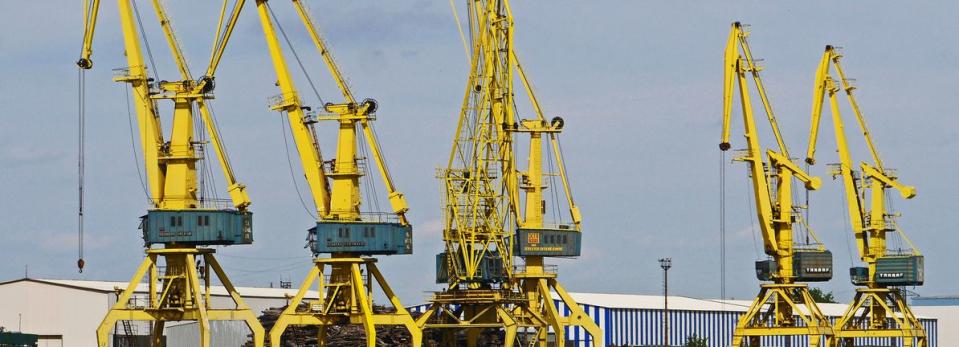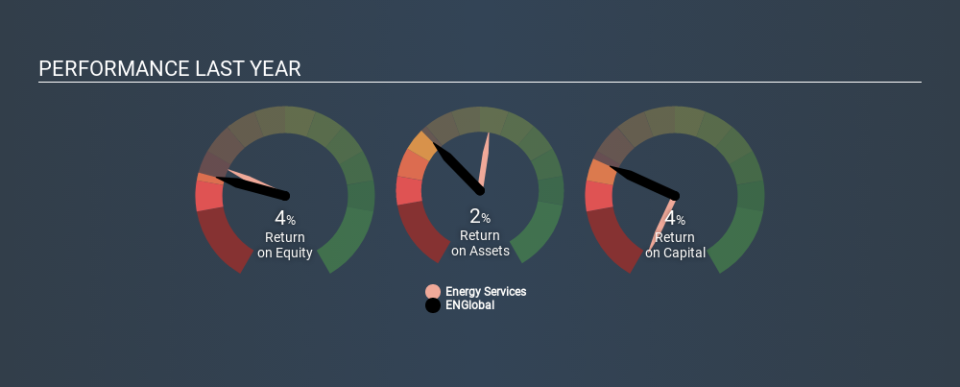Why ENGlobal Corporation’s (NASDAQ:ENG) Return On Capital Employed Might Be A Concern

Today we'll evaluate ENGlobal Corporation (NASDAQ:ENG) to determine whether it could have potential as an investment idea. Specifically, we're going to calculate its Return On Capital Employed (ROCE), in the hopes of getting some insight into the business.
First of all, we'll work out how to calculate ROCE. Second, we'll look at its ROCE compared to similar companies. Finally, we'll look at how its current liabilities affect its ROCE.
Understanding Return On Capital Employed (ROCE)
ROCE is a measure of a company's yearly pre-tax profit (its return), relative to the capital employed in the business. All else being equal, a better business will have a higher ROCE. Ultimately, it is a useful but imperfect metric. Author Edwin Whiting says to be careful when comparing the ROCE of different businesses, since 'No two businesses are exactly alike.
So, How Do We Calculate ROCE?
The formula for calculating the return on capital employed is:
Return on Capital Employed = Earnings Before Interest and Tax (EBIT) ÷ (Total Assets - Current Liabilities)
Or for ENGlobal:
0.041 = US$692k ÷ (US$29m - US$12m) (Based on the trailing twelve months to March 2020.)
Therefore, ENGlobal has an ROCE of 4.1%.
Check out our latest analysis for ENGlobal
Does ENGlobal Have A Good ROCE?
ROCE is commonly used for comparing the performance of similar businesses. Using our data, ENGlobal's ROCE appears to be significantly below the 6.5% average in the Energy Services industry. This could be seen as a negative, as it suggests some competitors may be employing their capital more efficiently. Regardless of how ENGlobal stacks up against its industry, its ROCE in absolute terms is quite low (especially compared to a bank account). It is likely that there are more attractive prospects out there.
ENGlobal delivered an ROCE of 4.1%, which is better than 3 years ago, as was making losses back then. That implies the business has been improving. You can click on the image below to see (in greater detail) how ENGlobal's past growth compares to other companies.
When considering ROCE, bear in mind that it reflects the past and does not necessarily predict the future. Companies in cyclical industries can be difficult to understand using ROCE, as returns typically look high during boom times, and low during busts. ROCE is only a point-in-time measure. We note ENGlobal could be considered a cyclical business. You can check if ENGlobal has cyclical profits by looking at this free graph of past earnings, revenue and cash flow.
ENGlobal's Current Liabilities And Their Impact On Its ROCE
Liabilities, such as supplier bills and bank overdrafts, are referred to as current liabilities if they need to be paid within 12 months. Due to the way ROCE is calculated, a high level of current liabilities makes a company look as though it has less capital employed, and thus can (sometimes unfairly) boost the ROCE. To counter this, investors can check if a company has high current liabilities relative to total assets.
ENGlobal has current liabilities of US$12m and total assets of US$29m. Therefore its current liabilities are equivalent to approximately 42% of its total assets. ENGlobal has a medium level of current liabilities (boosting the ROCE somewhat), and a low ROCE.
What We Can Learn From ENGlobal's ROCE
So researching other companies may be a better use of your time. Of course, you might find a fantastic investment by looking at a few good candidates. So take a peek at this free list of companies with modest (or no) debt, trading on a P/E below 20.
If you like to buy stocks alongside management, then you might just love this free list of companies. (Hint: insiders have been buying them).
If you spot an error that warrants correction, please contact the editor at editorial-team@simplywallst.com. This article by Simply Wall St is general in nature. It does not constitute a recommendation to buy or sell any stock, and does not take account of your objectives, or your financial situation. Simply Wall St has no position in the stocks mentioned.
We aim to bring you long-term focused research analysis driven by fundamental data. Note that our analysis may not factor in the latest price-sensitive company announcements or qualitative material. Thank you for reading.

 Yahoo Finance
Yahoo Finance 
